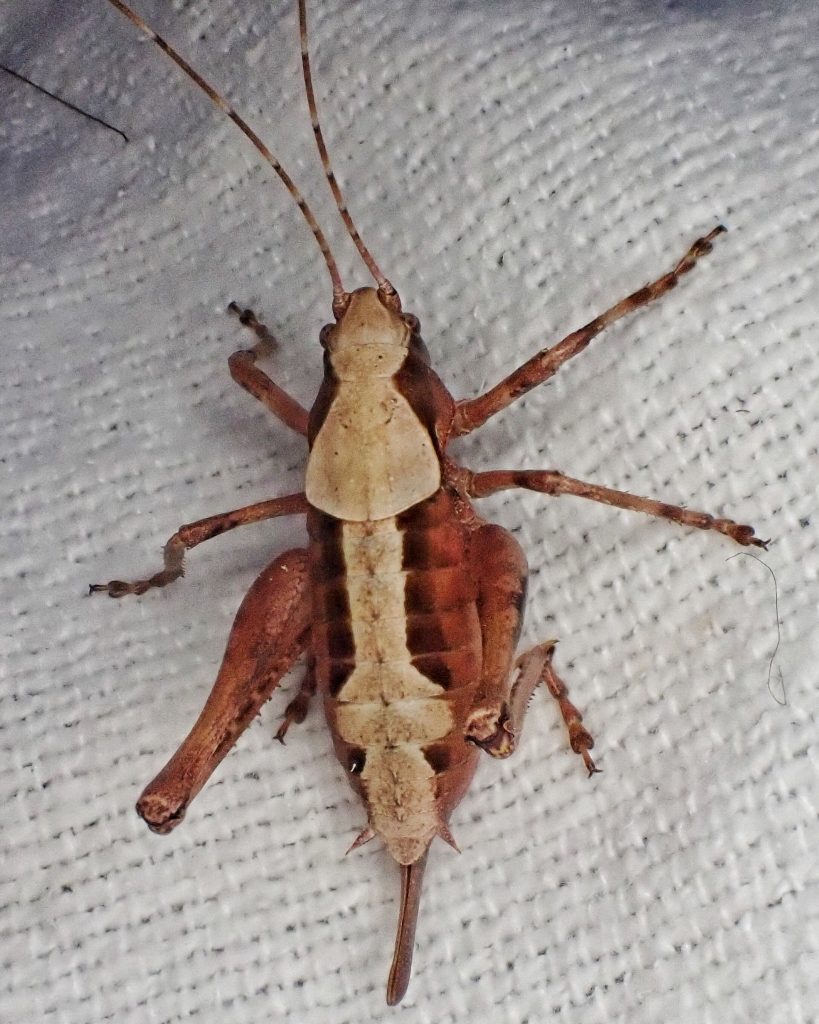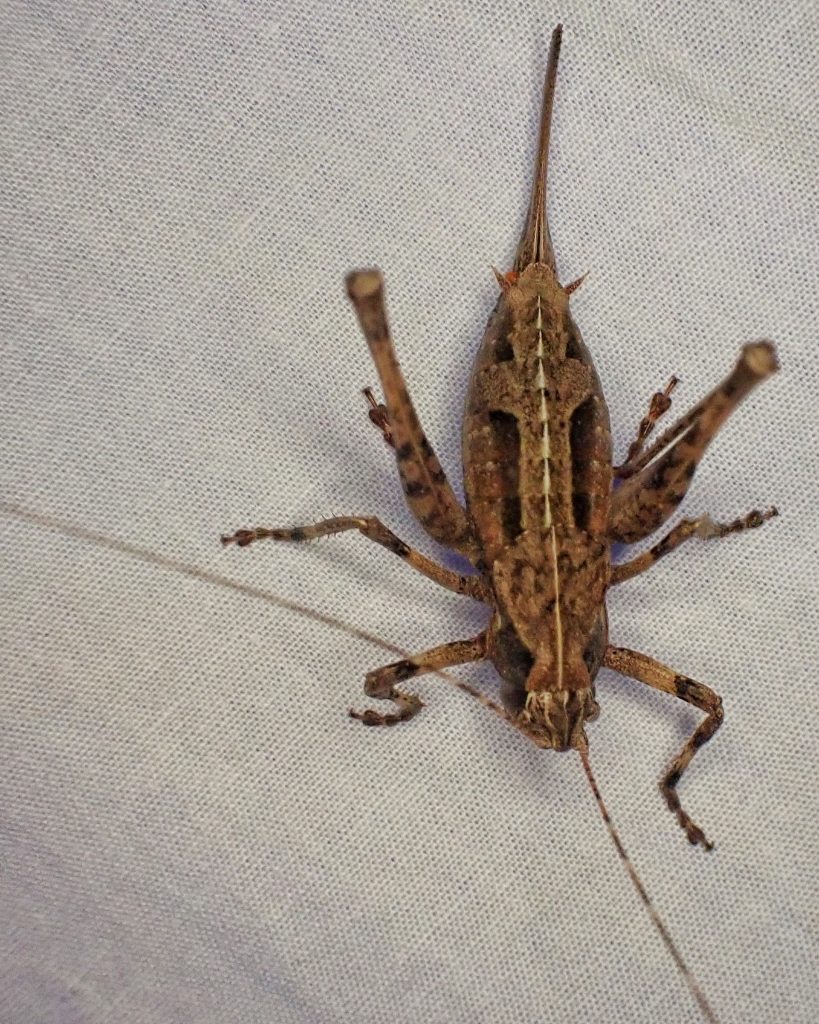
I found the first of these large female (you can tell by the scimitar-like ovipositor) orthopterans on Friday night, as I mentioned in 7th Night of Moth Week. But I was incorrect when I said this shield-backed katydid wasn’t in my insect book. It’s just that they have so much variation in color and pattern that I didn’t recognize the photo of Neduba steindachneri as being the bug I found. But, once I was back home with an Internet connection, I realized they had to be Neduba. Which one was the question, because in “Pacific Northwest Insects” Merrill Peterson said that the population of nw Oregon/sw Washington hadn’t been assigned a species. However, about three years later Cole/Weissman et. al. (https://orthsoc.org/sina/s140cwl2021.pdf) revised the genus and I was able to access that paper through the Orthoperterist’s Society entry for Genus Neduba (shieldback katydids)
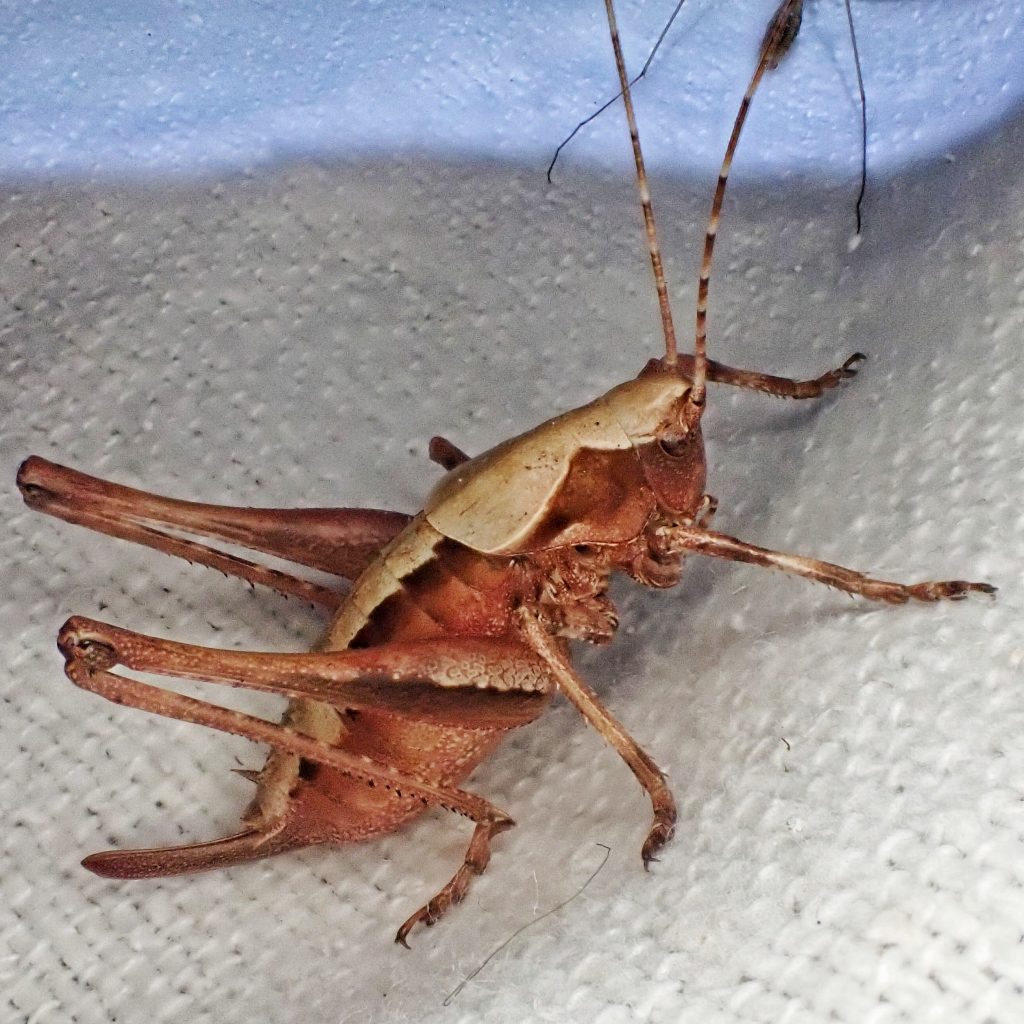
And I’m really glad that I could, because not only was I able to positively identify this big shield-backed katydid as Neduba steindachneri (since they determined that there are no other Neduba in Washington or n Oregon) but they were a fount of information about both the genus and species, information I just couldn’t seem to find elsewhere, and this would’ve been a much more perfunctory profile without their paper, from which I have quoted extensively. So that when I found another one on the 9th night of Moth Week I knew immediately what it was, even though it looked very different from the first one I found.
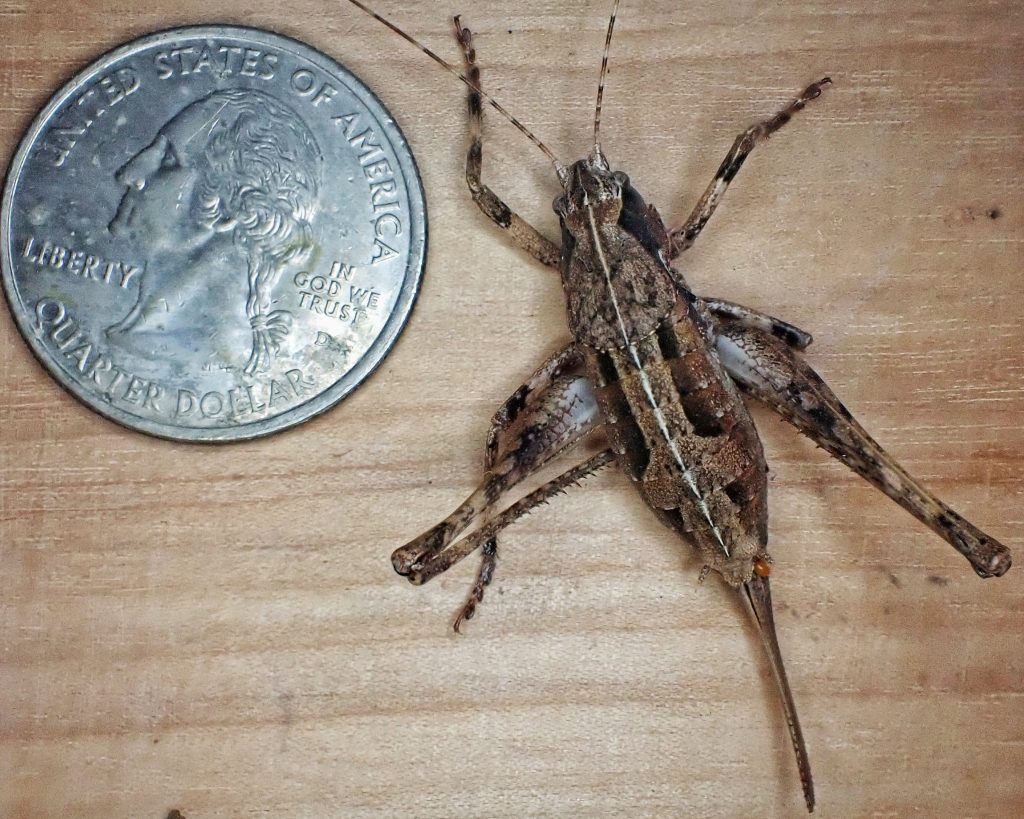
“Neduba are large, flightless inhabitants of the understory and leaf litter of western North American chaparral, oak woodlands, and conifer forests (Rentz & Birchim 1968). During the day individuals remain motionless in bark crevices (Rehn & Hebard 1909), in leaf litter, in tangles of vegetation, or in pack rat nests (J.A. Cole (JAC) and D.B. Weissman (DBW), pers. obs.). The katydids move little, even when disturbed, and are reluctant to jump. Individuals from the same population can vary greatly from one another in color pattern, for example a morph with a mottled dorsum (Fig. 1A) and a morph with a middorsal stripe (Fig. 1B). Color patterns are also shared among multiple species (Fig. 1C–D) and species groups, such as a countershaded morph with strong postocular bands (Fig. 1E–F). Color pattern diversity and the fact that color patterns are shared among species minimizes its utility in species identification.” https://orthsoc.org/sina/s140cwl2021.pdf
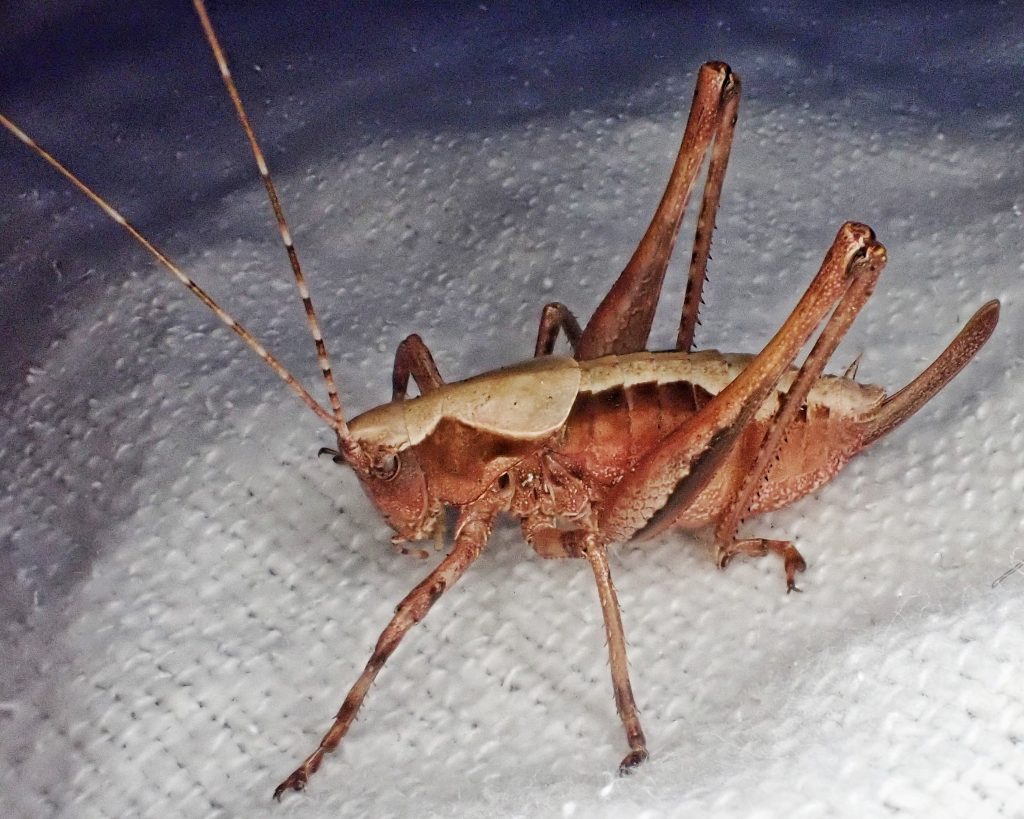
“Feeding, singing, courtship, mating, and oviposition take place at night. Neduba are omnivores, feeding primarily on the foliage of common plants in their habitats. Most species are associated with oak and conifer forests, and like the related Phymonotus some may feed on conifers (Lightfoot et al. 2011), a food preference that is rare among Orthoptera (Hojun Song pers. comm.) and that stems from nedubine ancestors that inhabited the ancient coniferous forests of western North America (Cole & Chiang 2016). Neduba may scavenge on dead insects but, at least in captivity, show no predaceous tendencies and do not behave aggressively towards each other, in contrast to other North American shield-back katydids like Capnobotes that may be predaceous, aggressive, and cannibalistic (Rentz & Birchim 1968; Tinkham 1944).” https://orthsoc.org/sina/s140cwl2021.pdf
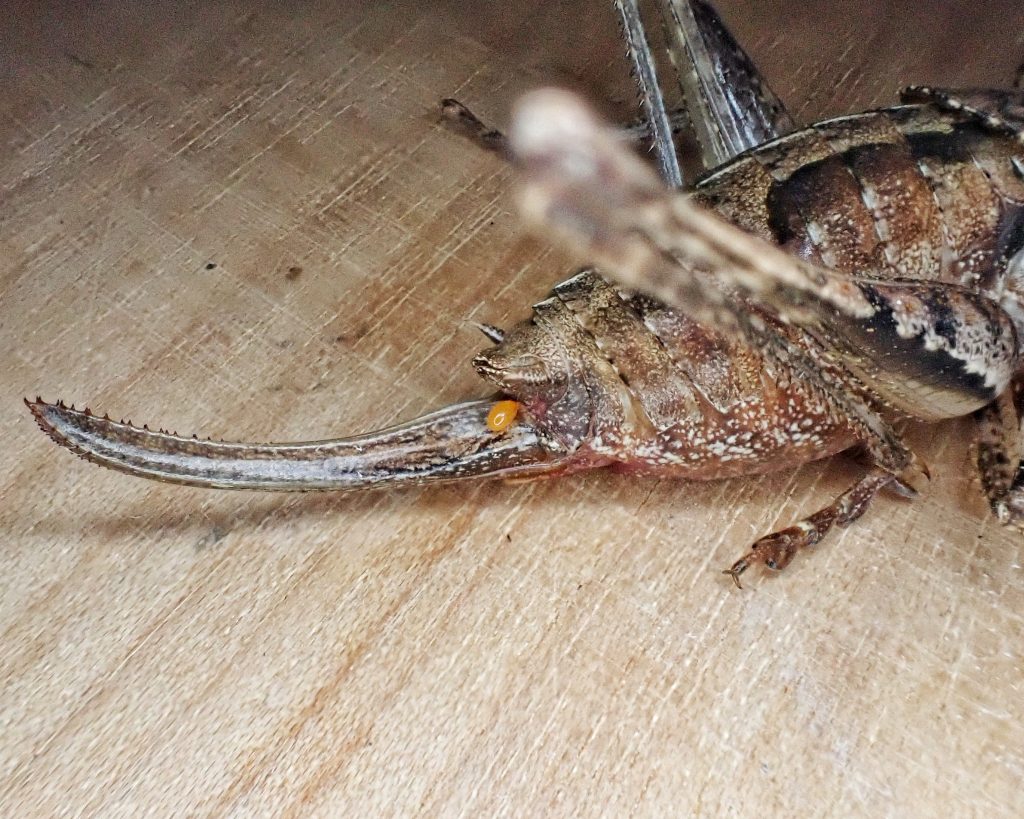
“The common name of shield-back katydid describes aptly the enlarged male pronotum in Neduba(Figs. 1, 2F) that largely or entirely conceals the small oval front wings (tegmina; Fig. 2F). The male tegmina are used only for sound production and females are completely apterous. Male Nedubaproduce continued high frequency calling songs of appreciable complexity (Fig. 2) that may be heard at night throughout summer and fall in suitable habitats. The enlarged pronotum, together with the dorsum of abdominal segments I–III act as an acoustic horn to amplify the calling songs produced by males (Morris et al. 1975). Females are mute and move towards calling males to form pairs (phonotaxis; Fig. 2G). Calling typically begins at dusk and continues throughout the night as long as tempera- tures do not dip too low, although a few species that inhabit northern latitudes or high elevations are adapted for activity at low temperatures (see Results). Males spend a great deal of time singing: duty cycles are frequently over 50% and may be as high as 90% (see Results). Neduba songs are broadband signals with peak frequencies centered high on the audible spectrum (range 11–17 kHz) and with sound energy extending well into the ultrasonic (Fig. 2C, limit of human hearing at white dashed line). Song structure complexity arises from alternating major and minor pulse trains (Fig. 2A, B; Cole 2010; Morris et al. 1975) that are produced during closing and opening of the tegmina, respectively. All Sierranus Group species and N. oblongata sp. n. in the Carinata Group have elaborated this pattern, producing multiple minor pulse trains that are produced by partial closing and opening wingstrokes (Fig. 2D-E).” https://orthsoc.org/sina/s140cwl2021.pdf
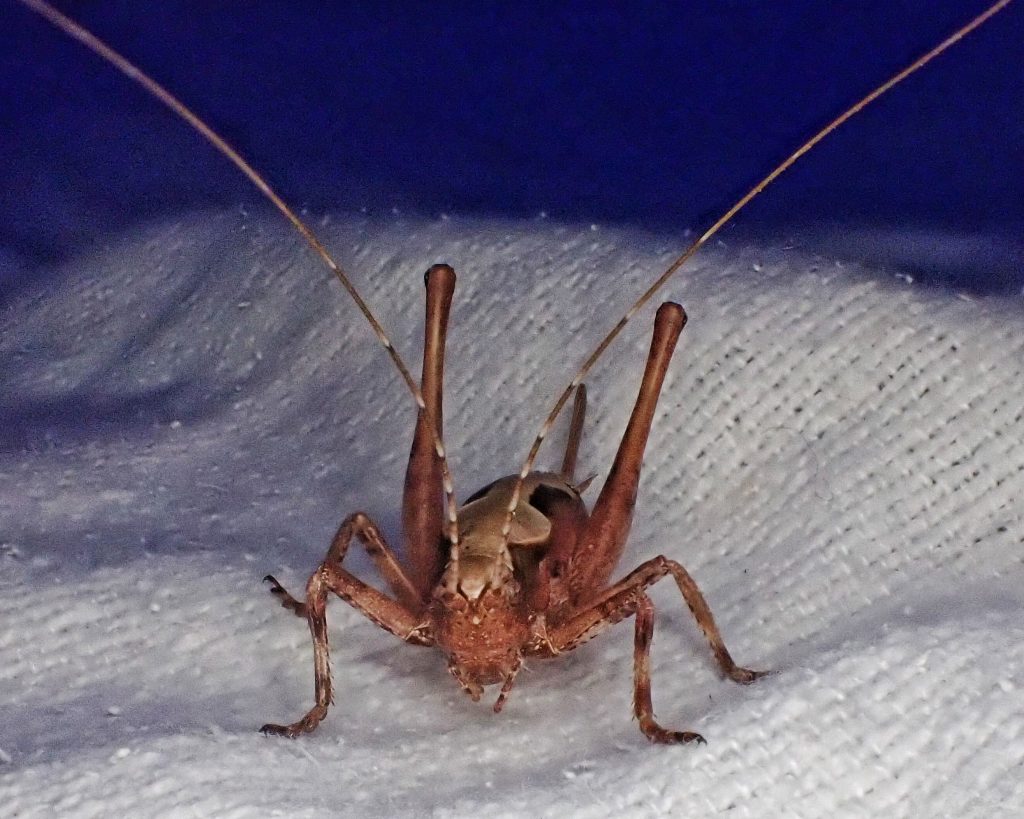
Description– Fairly large (15-40mm long, excluding ovipositor) grey to yellowish or reddish brown katydid with a large pronotum that has an elevated and rounded rear margin, and can be strongly contrasted in color to the body; “The male ventral sclerite is mushroom-shaped with a short, broad shaft and a wide, evenly curved apex with a short, blunt, recurved anterolateral projection. Tubercles are large, sparse, and confined to the apex. The titillators of N. steindachneri begin curvature after the midpoint of the shaft and are not as strongly curved dorsally (>90o) as seen in most other Carinata Group species (Plate 9). Stridulatory file tooth density (27–35 teeth/mm) The female subgenital plate is pentagonal, flat, subequal in length and width, and with curved apical margins and a strongly pointed apex, The song is unique in having reduced or absent OPT. The PTR is faster than all other convexa clade species. This species has the most northern range of any Neduba (Fig. 9).” https://orthsoc.org/sina/s140cwl2021.pdf
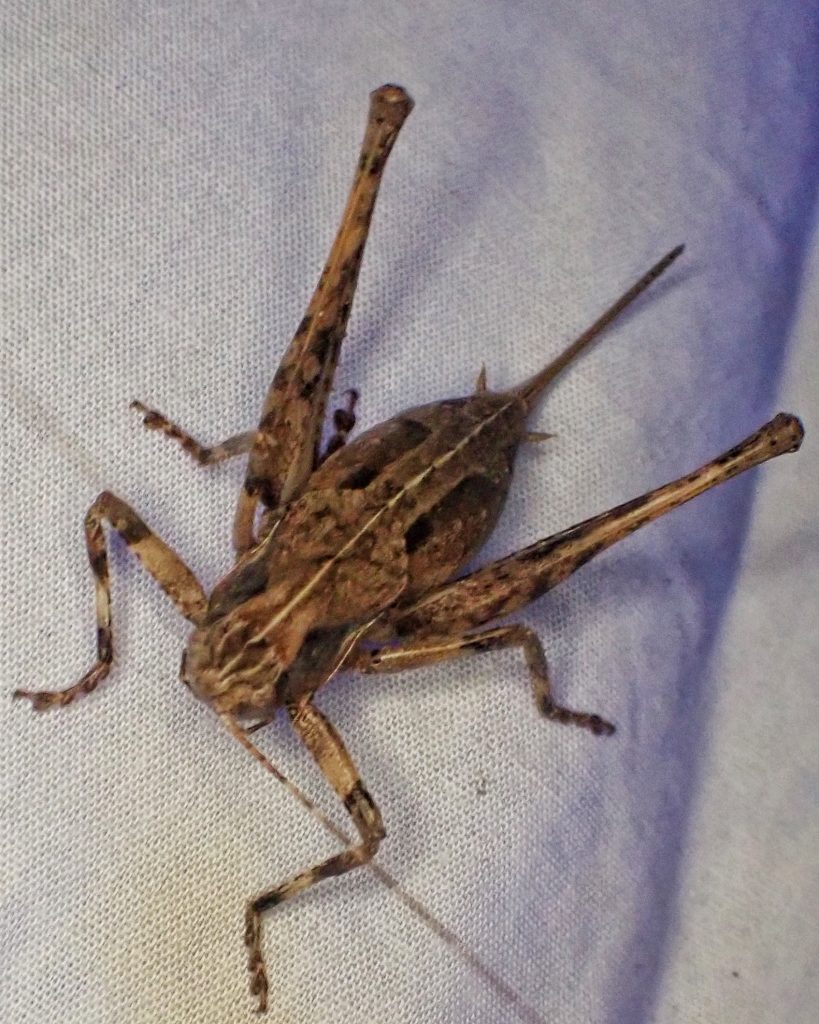
Similar species– Most species are most easily separable by location, with only Neduba convexa and N. cascadia (both found only in the southern Cascades, Siskiyous, and Klamath Mtns) being the only other Neduba likely to be found in our region; “Stridulatory file tooth density (27–35 teeth/mm) of N. steindachneri is lower than that of N. convexa (2-sample t-test, P = 5.48 ×10-3) and also trends lower than N. cascadia (33–39 teeth/ mm)…N. cascadia females which have straight apical margins and N. convexa and N. longiplutea females which have plates that are longer than wide.” https://orthsoc.org/sina/s140cwl2021.pdf, which also includes a key to the species of Neduba
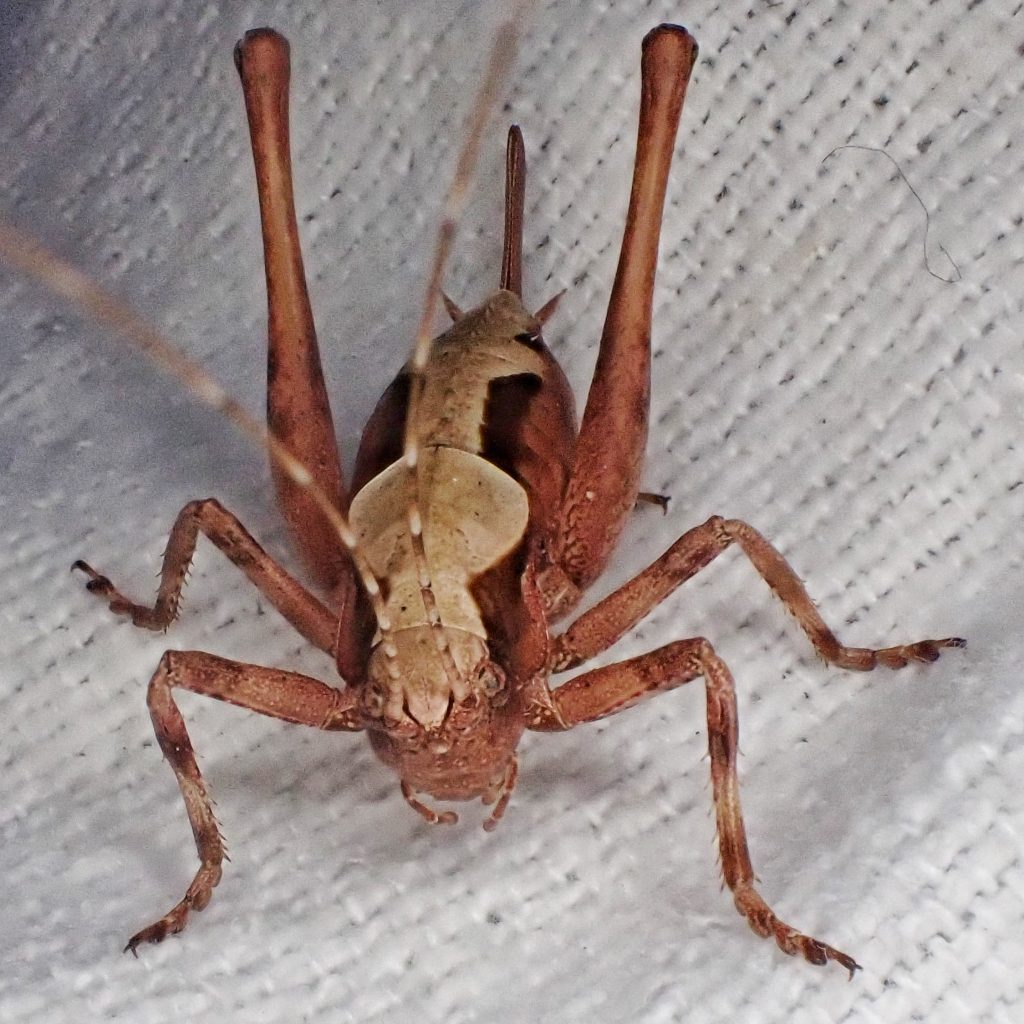
Habitat– “Understory of fir and fir-oak forests. On grasses, low branches, Ribes, and leaf litter.” https://orthsoc.org/sina/s140cwl2021.pdf
Range– “Central Oregon Cascade and Coast Ranges north to coastal British Columbia… N. steindachneri is locally common in the forest understory of the western slopes of Oregon and Wash- ington Cascade Range and primarily the eastern slopes of the Oregon and Washington coastal ranges. A phylogeographic break separates populations north and south of the Willamette River (Figs. 3–4) that suggests historical isolation ” https://orthsoc.org/sina/s140cwl2021.pdf
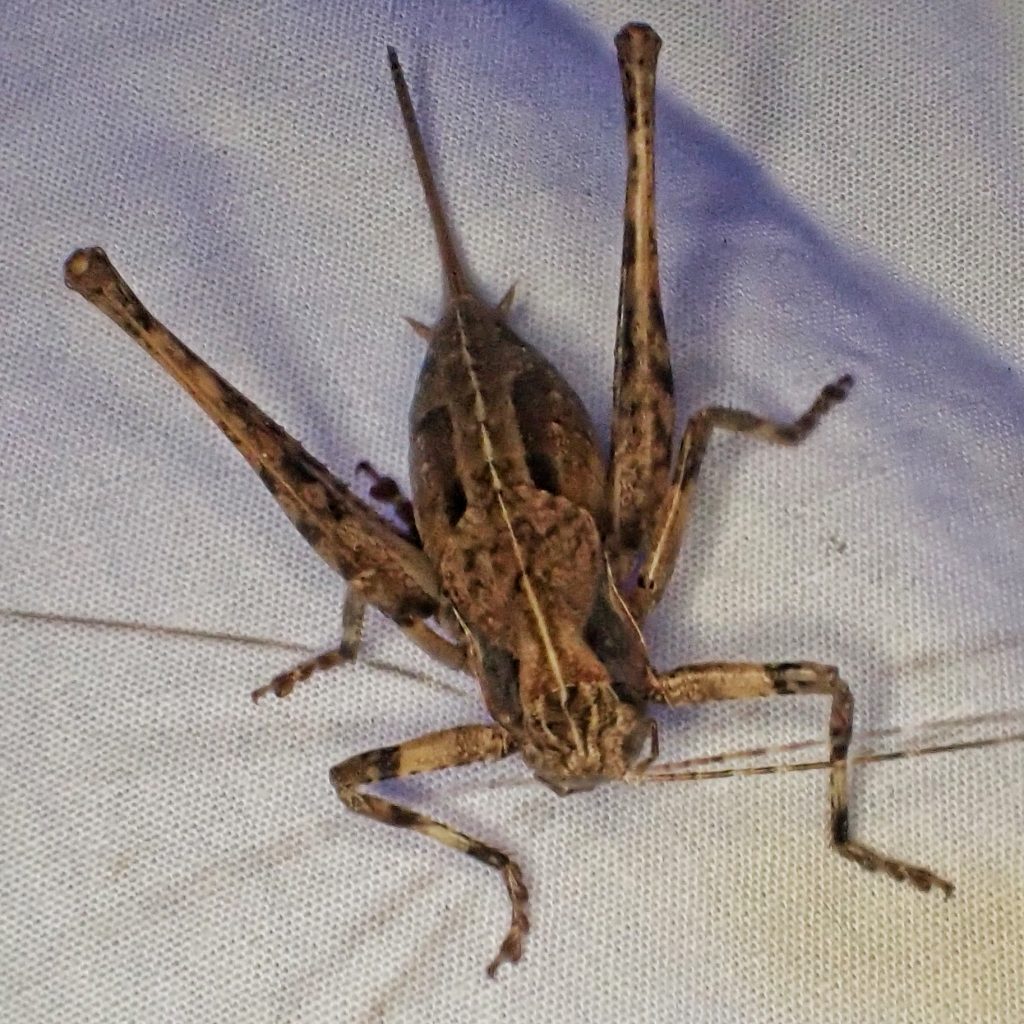
Eats– Primarily browses foliage, and may scavenge dead insects, but doesn’t appear to be predaceous.
Eaten by– Presumably a host for parasitoids in Hymenoptera and Diptera, and probably preyed upon by insectivores of all classes, but I can find nothing specific for this species.
Adults active– July through September
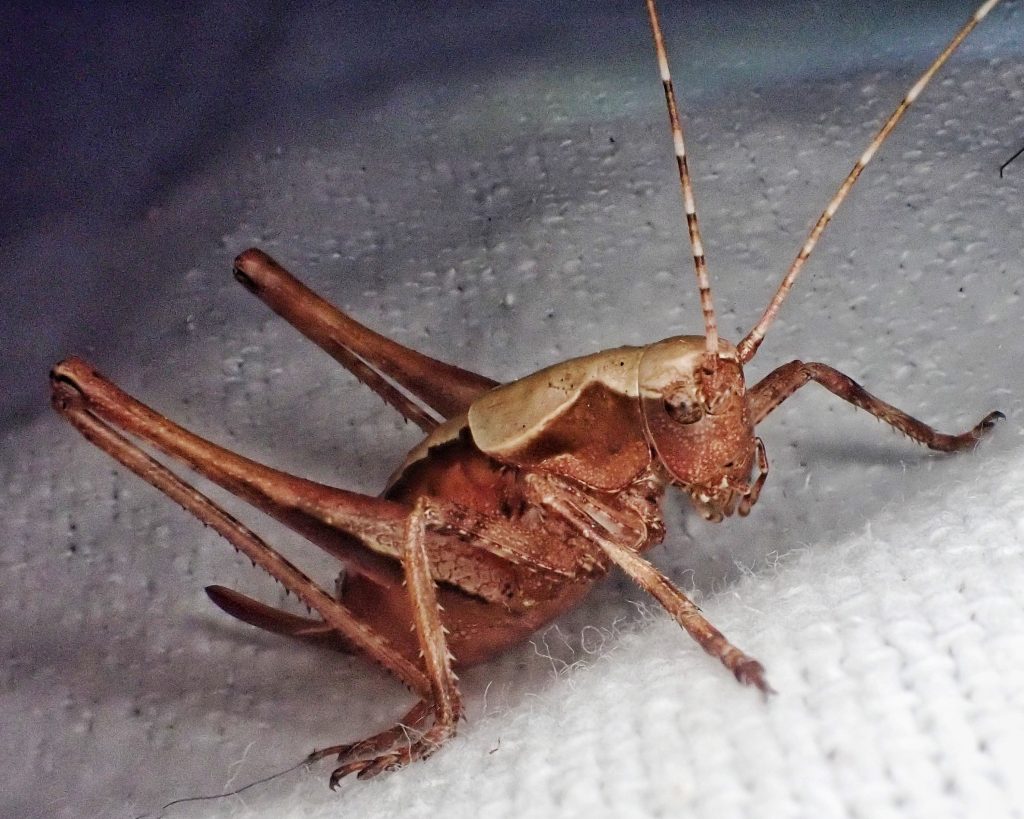
Life cycle– The only information I can seem to find on this is for the genus Neduba in general- “Eggs laid in late summer, cemented to plant stems, these overwinter; one generation per year”. Genus Neduba – BugGuide.Net
Etymology of names– Neduba “Etymology. Unknown. We speculate the name may be a combination of the Latin roots nedum (much more) and bas (base, pedestal, foundation, chord of an arc). This name describes the large, flat dorsal aspect of the shield-like pronotum, or alternatively the great arc formed by the posterior margin of the pronotum.” https://orthsoc.org/sina/s140cwl2021.pdf . The specific epithet steindachneri was named in honor of Franz_Steindachner, (1834-1919), an Austrian zoologist who specialized mostly in fishes, and reptiles and amphibians.
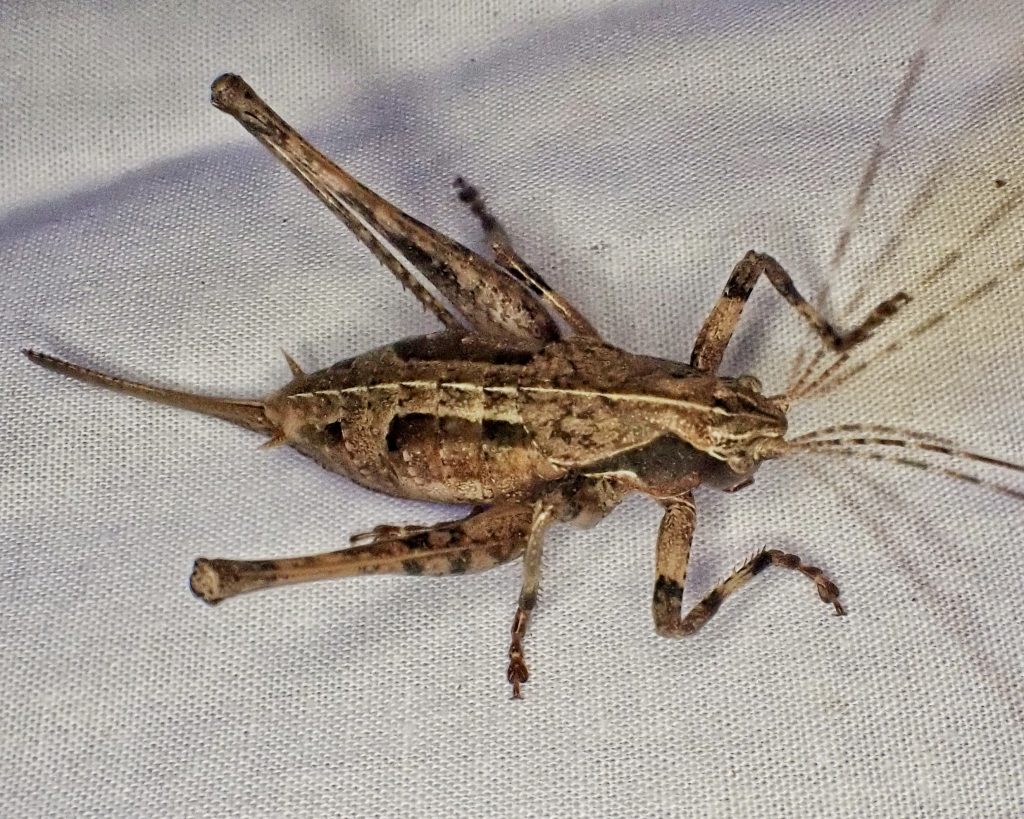
https://orthsoc.org/sina/s140cwl2021.pdf
Species Neduba steindachneri – Steindachner’s shieldback – BugGuide.Net
